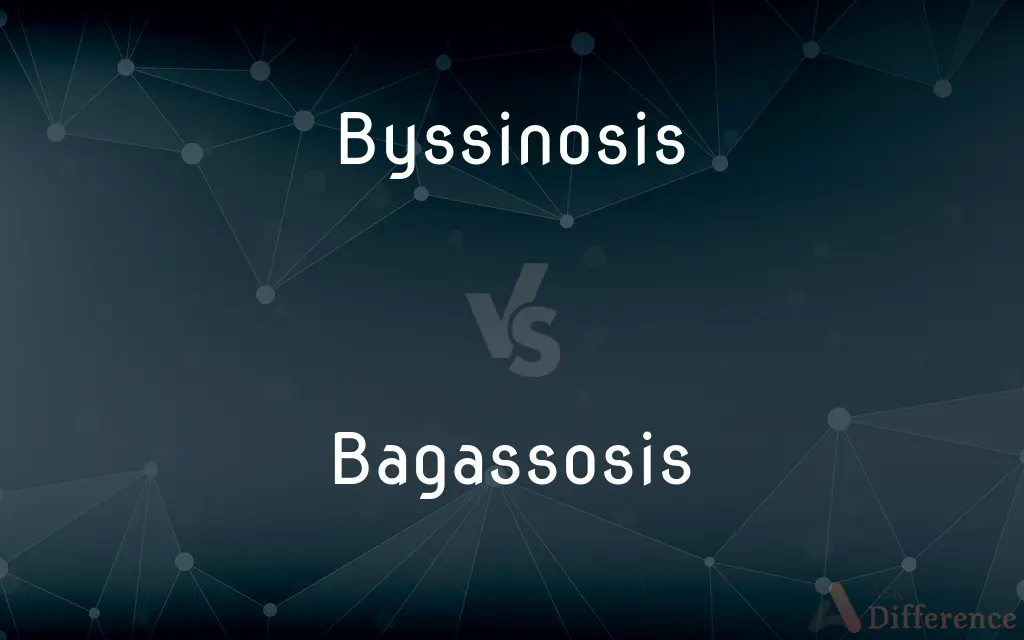Byssinosis vs. Bagassosis — What's the Difference?
By Urooj Arif & Fiza Rafique — Updated on April 1, 2024
Byssinosis results from cotton dust exposure, while Bagassosis is caused by sugarcane fiber dust.

Difference Between Byssinosis and Bagassosis
Table of Contents
ADVERTISEMENT
Key Differences
Byssinosis and bagassosis are both occupational lung diseases, but they stem from exposure to different types of dust in the workplace. Byssinosis, often called "brown lung," primarily affects individuals working in the cotton processing industry, resulting from inhalation of cotton dust. On the other hand, bagassosis is associated with the inhalation of dust from sugarcane fibers, commonly affecting workers in industries processing sugarcane.
Byssinosis develops due to repeated exposure to cotton dust, leading to inflammation and narrowing of the airways, which can cause chest tightness, wheezing, and breathing difficulties, especially at the beginning of the work week. It's a condition that illustrates how occupational hazards can significantly impact lung health, with symptoms that may improve away from the source of exposure.
Bagassosis, whereas, arises from exposure to the dust of sugarcane fibers, a by-product of sugar production. This exposure leads to an allergic reaction in the lungs, resulting in symptoms similar to those of byssinosis, including coughing, wheezing, and shortness of breath. However, bagassosis is specifically linked to the sugarcane industry and is considered a form of hypersensitivity pneumonitis.
The prevention and management of both conditions involve improving workplace air quality, wearing protective respiratory equipment, and, in some cases, changing work practices to reduce dust exposure. Despite these similarities, the industries and specific dust types causing byssinosis and bagassosis highlight the importance of targeted occupational health measures.
Both diseases underscore the need for rigorous occupational safety standards and health monitoring for workers in industries with high levels of dust exposure. While treatments may alleviate symptoms, the key to managing these conditions lies in prevention, primarily through reducing exposure to the offending dust.
ADVERTISEMENT
In essence, byssinosis and bagassosis reflect the broader spectrum of occupational lung diseases, emphasizing the critical role of environmental control in preventing respiratory conditions. Understanding the specific causes and mechanisms of each disease is vital for implementing effective workplace safety and health strategies.
Comparison Chart
Cause
Inhalation of cotton dust.
Inhalation of sugarcane fiber dust.
Affected Population
Workers in cotton processing.
Workers in sugarcane processing.
Symptoms
Chest tightness, wheezing, breathing difficulties.
Coughing, wheezing, shortness of breath.
Disease Type
Occupational lung disease.
Form of hypersensitivity pneumonitis.
Prevention
Improving air quality, respiratory protection.
Reducing dust exposure, respiratory protection.
Compare with Definitions
Byssinosis
Symptoms Include Breathing Difficulties.
Symptoms of byssinosis can worsen with continued exposure to cotton dust.
Bagassosis
Caused by Sugarcane Fiber Dust.
Workers exposed to sugarcane fiber dust can develop bagassosis.
Byssinosis
Result of Cotton Dust Inhalation.
Byssinosis occurs after long-term inhalation of dust found in cotton processing facilities.
Bagassosis
Hypersensitivity Pneumonitis.
Bagassosis is a type of hypersensitivity pneumonitis caused by sugarcane dust.
Byssinosis
Management Involves Exposure Reduction.
Changing work practices is essential for managing byssinosis.
Bagassosis
Similar Symptoms to Byssinosis.
Bagassosis shares similar respiratory symptoms with byssinosis, though its cause is different.
Byssinosis
Occupational Lung Disease.
Workers in the textile industry are at risk of developing byssinosis from cotton dust.
Bagassosis
Linked to Sugarcane Industry.
Bagassosis highlights the occupational hazards within the sugarcane processing industry.
Byssinosis
Preventable with Proper Protection.
Wearing protective masks can help prevent the onset of byssinosis.
Bagassosis
Protective Measures are Key.
Implementing air filtration systems in workplaces can reduce bagassosis risk.
Byssinosis
Byssinosis is an occupational lung disease caused by inhalation of cotton or jute dust in inadequately ventilated working environments and can develop over time with repeated exposure. Byssinosis commonly occurs in textile workers who are employed in yarn and fabric manufacture industries.
Bagassosis
Bagassosis, an interstitial lung disease, is a type of hypersensitivity pneumonitis attributed to exposure to moldy molasses or bagasse dust.
Byssinosis
An occupational respiratory disease caused by the long-term inhalation of cotton, flax, or hemp dust and characterized by shortness of breath, coughing, and wheezing. Also called brown lung disease.
Bagassosis
(medicine) A pneumoconiosis caused by the inhalation of dust from sugarcane processing
Byssinosis
A lung disease, caused by exposure to cotton dust in inadequately ventilated working environments.
Bagassosis
Alveolitis caused by inhaling bagasse (sugarcane dust)
Common Curiosities
Are the symptoms of byssinosis and bagassosis the same?
Symptoms are similar, including respiratory distress, but the diseases have different causes.
What industries are most at risk for byssinosis and bagassosis?
Cotton processing for byssinosis and sugarcane processing for bagassosis.
How can workers protect themselves from byssinosis and bagassosis?
Through improved ventilation, wearing protective gear, and minimizing dust exposure.
Is bagassosis a common occupational disease?
It's less common and primarily affects workers in the sugarcane industry.
Can lifestyle changes help manage byssinosis symptoms?
Avoiding tobacco smoke and maintaining a healthy lifestyle can help, but reducing dust exposure is crucial.
Are byssinosis and bagassosis recognized globally?
Yes, both are recognized occupational diseases, though prevalence varies by industry and region.
What is the main cause of byssinosis?
Long-term inhalation of cotton dust in textile industries.
Can byssinosis be cured?
There's no cure, but symptoms can be managed by avoiding further dust exposure.
What prevention strategies are effective against bagassosis?
Reducing dust levels and using personal protective equipment are key.
What research is being done on byssinosis and bagassosis?
Research focuses on understanding their pathogenesis, improving diagnosis, and finding more effective prevention strategies.
What are the long-term effects of bagassosis?
Without proper management, it can lead to chronic lung disease and respiratory failure.
How is byssinosis diagnosed?
Diagnosis is based on occupational history, symptoms, and lung function tests.
Is there a screening test for byssinosis?
Lung function tests can help diagnose byssinosis, especially in workers exposed to cotton dust.
How does bagassosis affect the lungs?
It causes inflammation and scarring in the lungs due to an allergic reaction to sugarcane dust.
Can home remedies treat bagassosis?
Home remedies cannot treat bagassosis; medical intervention and avoiding exposure are necessary.
Share Your Discovery

Previous Comparison
Centipede vs. Cockroach
Next Comparison
Knife vs. ShivAuthor Spotlight
Written by
Urooj ArifUrooj is a skilled content writer at Ask Difference, known for her exceptional ability to simplify complex topics into engaging and informative content. With a passion for research and a flair for clear, concise writing, she consistently delivers articles that resonate with our diverse audience.
Co-written by
Fiza RafiqueFiza Rafique is a skilled content writer at AskDifference.com, where she meticulously refines and enhances written pieces. Drawing from her vast editorial expertise, Fiza ensures clarity, accuracy, and precision in every article. Passionate about language, she continually seeks to elevate the quality of content for readers worldwide.















































